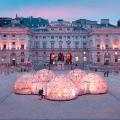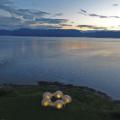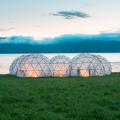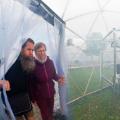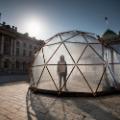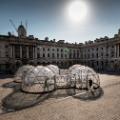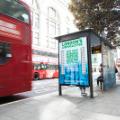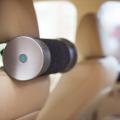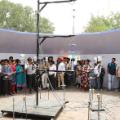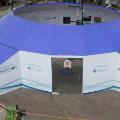(CNN)Like many expectant mothers, Sophie Power's biggest concern was the well-being of her unborn child.
Living in London where toxic air breaches legal limits, Power decided she needed to take matters into her own hands to protect her baby.
So she co-founded Airlabs with scientist Matthew Johnson of the University of Copenhagen in 2014, and together they devised a filter to remove dangerous pollutants from indoor spaces and effectively create pockets of clean air in London.
The same technology is now being used in Stella McCartney's new flagship store in central London.
How does it work inside vehicles?
The system was originally designed to remove pollutants inside cars, as studies have found that drivers are exposed to much higher levels of air pollution than those walking or cycling on the street.
Breathing in dangerous levels of nitrogen dioxide (NO2) can increase the risk of respiratory conditions and potentially stunt the growth of children's lungs.
While most in-car air filtration systems trap coarse particles such as pollen and dust, it is much harder to capture dangerous gases, like NO2, which is emitted by diesel vehicles in particular.
Currently, many cars are fitted with activated carbon filters, which can reduce NO2 from the cabin.
However, these filters often have a low amount of activated carbon and a limited ability to remove NO2, explains Uta Sager, Scientific Associate at the Institute of Energy and Environmental Technology in Duisburg, Germany.
Airlabs claims its nanocarbon filter ŌĆö the Airbubbl ŌĆö has a much higher capacity.
In 2016, researchers from King's College London found that the Airlabs system removed 87 percent of NO2 from the air, however Airlabs says this figure is now closer to 95 percent.
"When the gases pass through our filter there's a chemical reaction that absorbs them into our filter," Power tells CNN.
Like other filters, the Airbubbl can trap volatile organic compounds, ozone, and particulate matter.
But to be effective, Airlabs recommends changing the Airbubbl filter after 800 hours, or six to 12 months, of driving.
'Cleanest air in London'
Airlabs has retrofitted a similar filter into the ventilation system in the new Stella McCartney store in the West End of London.
"We all know the air outside is highly polluted, what we don't realize is that that same air goes into the building," explains Power. "What we are doing is taking the polluted air that would otherwise be coming in the ventilation system and making that completely clean."
McCartney says she designed her store to be a sanctuary to "get away from it all" ŌĆö hence the need for pure air.
"The moment you enter, you're hit with probably the cleanest air in London... which is something I'm really proud of," McCartney tells CNN.
"If you don't have clean air you don't have anything, and that's the core of everything I'm looking at as a human that inhabits this planet, as a business woman and as a fashion designer."
Cleaning outdoor spaces
In June, Airlabs launched what it called the "world's first open-air clean air zone" in New Delhi -- the Airhavn -- in collaboration with British energy and environment company Evergen Systems.
The structure serves to test and demonstrate large-scale outdoor cleaning in a 10-meter wide open-air structure. Airlabs hopes to apply this technology to larger city projects like shopping streets and transport networks.
The results have yet to be verified, but the company says it has monitored a pollution reduction of up to 90%.
While Airlabs is focused on removing toxic gases from the air, an international team of scientists has developed a new material to capture gases directly from the source ŌĆö such as a vehicle's exhaust pipe.
The material is a metal-organic framework that acts as a sponge to trap gases, according to a study published in "Nature Materials."
Dr Sihai Yang, one of the study's lead authors and a chemistry lecturer at the University of Manchester says actively removing NO2 from the atmosphere will continue to be a big priority as we will rely on carbon fuels ŌĆö coal, petrol or diesel ŌĆö for the next 30 to 50 years.
He adds that the Airlabs filter, while essentially a commercial product, could be a practical solution to tackle this environmental problem in micro-environments.
"I think it is a promising direction to move forward," says Yang. "In the future, to have air filters installed in cars or in the household for domestic applications is going to be quite important."













